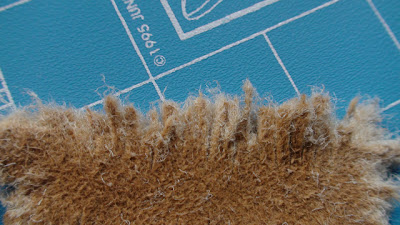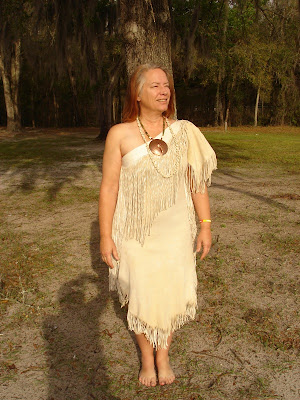Art. II. Seed Beads in the Northwest. In which J. GOTTFRED presents information on small glass beads based on the archaeological evidence from Fort George (1792-1800), Rocky Mountain House (1799-1821), and the Boyer Post and Aspen House sites (1788-1802)
There is some confusion among re-enactors concerning what beads are correct to use for beadwork decoration on reproduction clothing and other items dating to before 1821. In this article I will present information from three archeological reports concerning small glass beads found at fur trade sites dating from 1788-1821. I will also discuss what modern beads are the closest to these historic beads in size, shape, and color. Some of the confusion regarding small beads comes from the fact that people use the same terms to describe different beads. Modern seed beads are classified by size number. Usually, seed bead sizes range from size 2 (large) to size 14 (tiny). Size 2 beads are almost as big as a modern pony bead, while the size 14 beads are about a millimeter in diameter. The most popular size with modern craft workers seems to be size 10, with a diameter of about 2.5 mm. Today's 'pony beads' or 'crow beads' are large beads, usually plastic, with a large hole and a diameter of 9 mm. They are often used to decorate fancy bandannas and leather fringes. Historic seed beads are defined as being under 2.0 mm in diameter (Nobel, 143). Historic 'pony' or 'pound' beads are larger than 2.0 mm, generally between 2.0 and 4.0 mm (Kidd, 175). Modern size 6 to size 10 beads are the same diameter as historic pony beads, while modern seed bead sizes 11 to 14 have the same diameter as historic seed beads. There does not appear to be a historic analog to modern pony beads, although there were other types of large beads.
Beads at Fort George 1792-1800
Fort George was a North West Company post located on the North Saskatchewan River near the town of Elk Point, Alberta. It operated from 1792 to 1800. During the years 1965 to 1967, 20,588 small glass beads were recovered from the Fort George site (Kidd, 175). Most of them were 'pound beads' or 'pony beads', with diameters generally between 2 and 4 mm (Kidd, 175). (A size 10 seed bead is about 2.5 mm in diameter, while a size 6 seed bead is roughly 4.4 mm in diameter.) The archeologists further classified the beads into three shape categories, 'flat' beads have diameters greater than their length, 'square' beads are as long as they are wide, and 'elongated' beads are longer than their diameter. Most modern seed beads are 'flat'. At Fort George, the three shape categories broke down in the following way (from data in Kidd, 176):
Unlike modern beads, two thirds of the small beads have a 'square' profile. Modern beads also have more rounded edges (shaped like car tires), where as the historic beads had square edges, more like modern 'cut' beads (like short lengths of pipe). It should also be noted that the historic beads were much less regular in size than modern beads.
The main colors of the beads excavated at Fort George were white and blue. Two-thirds of the remainder were red, while green and wine-colored beads made up most of the rest. Beads at Rocky Mountain House, 1799-1821
Rocky Mountain House was a North West Company post located on the North Saskatchewan River just south of the town of Rocky Mountain House, Alberta. It was open from 1799-1821. The site yielded 151 seed beads less than 2 mm in diameter, and 10,539 'square' beads with diameters ranging from 2.1 to 4.0 mm (Noble, 145). At Rocky Mountain House, most of the beads were 'square' ; only 176 beads were 'flat'. Noble notes that 'the comparatively low number of seed beads at Rocky Mountain House is in contradistinction to bead samples from other historic forts' and that the 'data suggests that the Rocky Mountain House seed bead sample is very low. This may be a function of time, different suppliers or simply due to a preference on the part of the Indians.' (Noble, 144-145) They found 10,522 beads at Rocky Mountain House. Blue beads made up 69% of these beads, and white beads were the remaining 31%. There were also 17 red beads.
Beads at the Boyer Post and Aspen House sites (1788-1802)
The Boyer Post and Aspen House were North West Company posts located at the forks of the Boyer and Peace Rivers in Northern Alberta. The site is very near Fort Vermilion, Alberta. Only 73 beads were recovered from the site, but their color distribution is similar to the other sites' with the vast majority of beads being evenly split between white and blue, with remainder composed of red and yellow in equal proportions.
Combined Data
If we combine the small bead data from all three sites, we find that out of a total of 31,138 beads, 57% are white, and 29% are blue. The remaining 14% is predominantly red.
Analysis of Bead Patterns
Museums contain many different examples of beadwork patterns. Unfortunately, most of these items date from the late 19th or early 20th centuries. However, if we assume that they are representative of earlier patterns, it might be interesting to compare the representation of bead colors in these patterns to the distribution of bead colors at archaeological sites. I will present a breakdown of two geometric patterns that I have reproduced from historic examples. The first is a reproduction beaded strip from the arms of a Plains Cree man's shirt that used 14,400 modern size 10 beads. The pattern consisted of pairs of yellow triangles bordered in black on a white background.
The second example is of a beaded strip from the front of a Blackfoot man's shirt. This is a variation of the Blackfoot 'mountain' pattern, which might be described as blue triangles bordered with black borders and colored details on a white background. I have reproduced one pattern of 4,384 size 10 beads. When extrapolated to the size of the original garment's beaded strip, this pattern would comprise some 35,072 beads with the following color breakdown :
The color distributions of the two patterns are similar to the color distribution of the beads from the three historic sites, and would suggest that historic bead patterns were of the same general form, namely a background field of white, with predominantly blue colored designs placed at regular intervals within the field.
Conclusions
Historically, the term 'seed bead' refers to beads less than 2 mm in diameter. The historic term 'pony bead' refers to beads of between 2 mm and 4 mm in diameter, but the beads craft stores call pony beads are usually much bigger than that. Historic 'pony beads' correspond in size to modern size 6 to size 10 seed beads. (2-4 mm diameter). In scaled photographs of pony beads from the Fort George and Boyer/Aspen sites, most correspond to modern size 6 seed beads (4 mm diameter). Most beads were white and blue. This may indicate that these two colors were preferred for use as the background colors for fully beaded designs. Two-thirds of historic beads were of the 'square' form, with the remainder split between 'flat' and 'elongated' forms. For the re-enactor, this data would suggest that beadwork consistent with archeological evidence covering the period 1792-1821 in Alberta would use modern size 6 (4mm) seed beads, in patterns using white or blue as the main or background color, with periodic designs of yellow, red, black, green, or wine. The greatest challenge to the re-enactor is obtaining 'square' type beads. Using 'flat' forms would not be totally inconsistent with the archeological record, but I suspect that a pattern made only with 'flat' beads would not be typical for the time. Modern seed beads have rounded edges and are very flat. The most common historic beads were more 'square', and had edges that were generally much less rounded than the edges of modern beads.
References
Kidd, Robert S., Fort George and the Early Fur Trade in Alberta. Provincial Museum and Archives of Alberta Publication No. 2, 1970 Noble, William C., 'The Excavation and Historical Identification of Rocky Mountain House' in Canadian Historic Sites : Occasional Papers in Archaeology and History No. 6. National Historic Sites Service, National and Historic Parks Branch, Department of Indian Affairs and Northern Development. Ottawa, 1973. pp. 56-163 Pyszczyk, Heinz W., 'A 'Parchment Skin' is All : The Archaeology of the Boyer River Site, Fort Vermilion, Alberta' in The Uncovered Past : Roots of Northern Alberta Societies, Patricia A McCormack, ed. Circumpolar Research Series Number 3, Canadian Circumpolar Institute, University of Alberta, Edmonton, 1993. pp.33-44. | 






























 ely to meet some people who are Wampanoag--one of several Peoples (or Nations) indigenous to the southern coast of present-day New England. The Wampanoag have been living here for over 10,000 years.
ely to meet some people who are Wampanoag--one of several Peoples (or Nations) indigenous to the southern coast of present-day New England. The Wampanoag have been living here for over 10,000 years.






